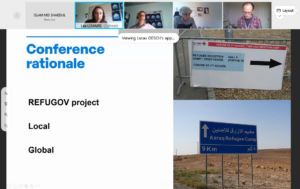Introduction Lucas Oesch and Léa Lemaire (University of Luxembourg)
Refugee reception and the challenge of ‘the local’ Jonathan Darling (Durham University)
Recent years have seen a growing focus on the role of multiple ‘local’ actors in shaping, and implementing, policies and practices towards refugee reception and accommodation in both the Global North and the Global South. Driven in part by attempts to recognise and account for the complexities and ambiguities of governance in contexts of displacement, this work has drawn attention to diverse relations between local governments, international humanitarian organisations, private contractors, NGOs, and public and private service providers. In this paper, I critically consider how ‘the local’ is understood in such discussions, and argue for a need to take seriously the relational constitution of a ‘local turn’ in refugee studies and refugee reception. The paper does so in two ways. First, it considers the diversity of conditions, institutions, and infrastructures that have come to be aligned with ‘refugee reception’. From community hosting and housing initiatives that seek to offer wide-ranging social support and solidarity, to institutional spaces that ‘warehouse’ refugees at the social and geographical margins of the state, the terminology of ‘reception’ addresses a multitude of conditions and experiences. In such a context, I argue that considering ‘local’ negotiations of policy, rights, and entitlements may offer useful insights into the constitution of reception. However, such consideration must be wary of territorially fixing the ‘local’ as a container. Rather, in the second half of the paper, I draw on Doreen Massey’s relational account of a ‘politics of place beyond place’, to argue that accounts of ‘local’ actors and negotiations, require a nuanced recognition of how policies and practices of refugee reception are co-constituted with, and by, place. In this sense, practices of reception are always both territorially and relationally embedded, connected both to the places they help constitute and multiple networks of policy, governance, and influence that extend far beyond ‘the local’. At the same time, this relational politics foregrounds how apparently ‘local’ actions may reverberate far beyond the bounds of place and shift understandings of ‘reception’ itself. It is with these political considerations that the paper concludes, in foregrounding the work of grassroots hosting schemes and solidarity networks that reject normative models of ‘reception’.
What camps can do? Disspossession and inhabitation Camillo Boano and Hanadi Samhan (University College London)
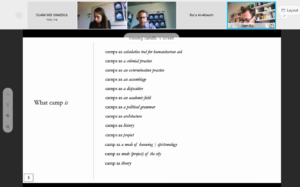
Paraphrasing Deleuze, this paper is an attempt ask ‘what camps can do?’ However you wish to define them, semantically represent the paradoxical encounters between a series of governmental forces, disciplinary knowledge, aesthetic regimes and spatial conditions that tend to arrest, fix in time and space forms of lives. As starting point, the camp remains a rare object of study that can exist, simultaneously, in the realm of theory, in the space of matter and in the form of multiple agency. It is an ideological thought and a formal dispositive, one that antagonises the spatial precepts of modernism through its heavily loaded political semantics. Beside the wide spectrum of camp-like typologies, is in its bare essence a dispositif that explicitly determine the other, the unknown and the uncontrolled in what Mezzadra and Neilson, called “the different assemblages of power and the different forces of capital through which they are fragmented, recombined and produced”. Using somehow playfully the concepts of ‘dispossession’ developed by Butler and Athanasiou and the one of the ‘pluriverse’ developed by Escobar, I would like to stress two different but interconnected points: on one side, I hope to rescue Agamben’s work from its linear reading by commenting on the depoliticization of the camp and the critique of its exceptionalism; and, on the other, I wish to reflect around the urban-camp debate, introducing the disruptive terminology of inhabitation. With narratives from Middle East, Asia and Europe the paper wish to start grasping the possibility to decolonialise camp scholarship.
Supercamp: The Middle East as Regional Refugee Camp Are John Knudsen (Chr. Michelsen Institute)
This paper takes a regional approach to encampment, thus expanding the spatial scale of refugee containment. In historical perspective the Middle East has been a refugee producing- and hosting region since the mid-18th century with forced displacement and deportation regimes starting as empires and states clashed and broke up leading to the first humanitarian relief, food aid and tented camps from the early 19th century. The interwar and post-WWII period’s massive displacements led to formalizing the legal and institutional framework for the international protection to refugees (1951 Refugee Convention) as well as established camps for refugees in Europe and the ME. In the latter, this began an era of encampment, that instituted camp-based responses to refugee crises as the default emergency measure to forced displacement in ME-region and beyond. In the 1990s, inter-state and interventionist wars led to new displacements that were mostly contained within the ME region. Finally, the Syrian civil war (2012–present) and subsequent displacement crisis led to new border controls, containment and return of refugees and migrants. Efforts to resolve the “European migration crises” implicated the ME in the EU’s migration management, thus becoming a refugee- hosting region that bridges the North-South divide through a system of detention and return. To this end the paper argues for extending the camp-analogy to include internment in a geographical region, hence a Supercamp can be defined as bio-political region of forced immobility under humanitarian governance that is subsidized by an economic aid regime. In this respect, the formation of a Middle East Supercamp can be considered an outgrowth of Orientalism’s imaginative geography of the Middle East.
Researching reception facilities for refugees across the global South and North Léa Lemaire and Lucas Oesch (University of Luxembourg)
The governance of reception facilities for refugees is often considered by scholars to be a different process whether the ‘camp’ is located in the global South or in the global North. Consequently, the field of camp studies has scarcely, and only recently, started to address the question of camps on a global scale. While recognizing the many existing differences, for example in terms of geo-political contexts and socio-economic situations, in this paper, we explore how the governance process of camps can be studied across the global South and North, by focusing on the question of infrastructures. To do this, we focus on the case studies of Jordan and Luxembourg. We draw on the approach of comparative urbanism, which advocates putting into perspective similar processes taking place in highly diverse localities across the globe. We also operate a methodological inversion by taking the global South as a starting point, and by considering how research on the well-studied case of refugee reception in Jordan, and in general of infrastructures related to refugee reception in the global South, can shed an innovative light on the under-studied case of refugee reception in Luxembourg. Indeed, research on refugee camps in the global South in general, and in Jordan in particular, has made an important place to the question of infrastructures in camps, such as water and electricity provision or waste management, while this has been less the case in the global North. Through a study of infrastructures in reception facilities in Jordan and Luxembourg, this paper aims to contribute to the development of a more global approach in the field of camp studies.
Accommodation of asylum seekers in former tourism infrastructures in Austria Nina Kolowratnik (Ghent University) / Johannes Pointl (TU Wien)
This paper proposes a spatial reading of accommodation of asylum seekers in former tourism infrastructures in Austria. It lays out why small- scale hotels and bed and breakfast establishments are predominantly used and illustrates the challenges both guests and hosts are facing in the absence of spatial guidelines for asylum seeker accommodation that acknowledge the needs of forcibly displaced people and facilitate a sense of arrival. The persistence in using tourist accommodation as a place of refuge since the 1950s is a consequence of the over-supply of low- standard or unclassified tourist facilities in often remote parts of Austria as well as of the strategic advantages that the small-scale structure of the tourism industry provides for the Austrian asylum system. Proprietors are both responsible for the operation of the accommodation and expected to care for people in need of protection with special (housing) needs. There are no minimum standards for the accommodation of asylum seekers but only extremely vague guidelines to be followed by both provincial governments and proprietors. The process of transforming a tourism establishment into accommodation for asylum seekers does not require Austrian proprietors to show evidence of any special training in the provision of space and care for asylum seekers nor to employ qualified staff. Far too often it is left to operators of accommodation to determine whether the space provided allows not only for physical but also psychological refuge and offers an environment with which the refugees can identify and in which they can rediscover the notion of living.
The political geography of rehabilitation in Hungary Patrick Ciaschi (The New School for Social Research)
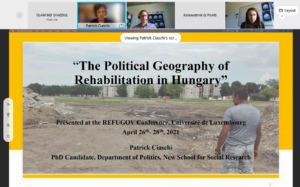
Curtailed rights and precarious labour statuses are common marginalizations shared between detained asylum seekers and other ‘surplus’ vulnerable populations globally. In Hungary, a convergence of containment strategies between these populations has occurred (Rajaram 2015). Spatial interventions by non-state and humanitarian actors in the name of territorial and population rehabilitation have arisen; most notably, in segregated neighbourhoods with high Roma populations. Across Hungary, the Order of Malta has monopolized this space, and has deployed localized“presence” (jelenlét) programs to police and ‘build community’ for vulnerable inhabitants. Within contexts of rehabilitation, thinking through ‘the camp’ is an important theoretical concept to understand the emergence of new spatial configurations of power. Despite a breadth of research on racialized and segregated Roma urban encampments across Europe, quite often this research overlooks the practices of and infrastructures produced by embedded actors. As more rehabilitation programs emerge, the complexity of these spaces demand alternative conceptual spatial and temporal frames. This presentation contextualizes, and suggests, the emergence of a field of rehabilitation management in current day Hungary. Through an ethnographic study of an urban neighborhood undergoing rehabilitation in the Hungarian city of Miskolc, this paper examines the resilience models implemented, the extractive methods deployed, and the actors involved in creating and bordering this rehabilitative space. Further, the paper will reflect on the emergence of such a field as a reconfiguration of state space within urban environments, and considers its emergence as a paradigmatic shift in the political geography of containment across the Global North-South divide.
In the camp but not of the camp: the incorporation of Bangladeshi host communities in Rohingya refugee camps Yasmin Khan (University of Toronto)
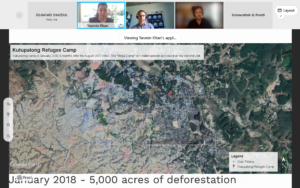
This paper is an investigation of a unique manifestation of camp geography: the forced incorporation, since 2017, of existing Bangladeshi communities within Rohingya refugee camps. The repercussions of refugee policies that have shaped these camp spatialities have spurred socio-economic and environmental impacts for Bangladeshis not recognized as full residents of the camp and therefore not receiving humanitarian aid. We argue that this unique situation deserves scrutiny, since exploring impacts of camp spatialities in relation to local host communities is urgent as campscapes are expanding their effects globally, and particularly in the Global South. Here we analyze three Rohingya camps that have surrounded Bangladeshi households by privileging the view of host(ed) community members and reflect on how they articulate and react to the consequences of these campscapes in their lives – especially when already confronted by social, economic, and environmental challenges. Finally, we suggest that these camps are powerful spatial political technologies at the source of new forms of marginalization having lasting impacts for the forcibly ‘incorporated’ Bangladeshi communities whose presence seems to have been omitted from the statistics, policies, and operations of the organizations involved in camp management.
Informal refugee mobilities in Belgrade, Serbia Jessica Collins (Macquarie University) / Claudio Minca (University of Bologna)
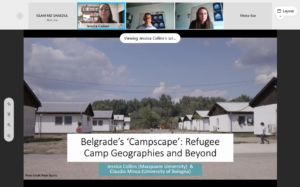
This paper discusses the informal refugee mobilities and spatialities in Belgrade, with a particular focus on the role played in this by the official refugee camps of Krnjaća and Obrenovac, located on the outskirts of the Serbian capital. These new informal geographies have emerged in response to long periods of stay by ‘irregular’ migrants in Belgrade and its vicinity. Particular attention is given to the development of refugee spatialities since the 2017 eviction of the so-called Warehouses Camp – a makeshift camp behind the central Belgrade train station which housed nearly 2,000 people at its peak – and to the increasingly ever-changing needs of the ‘irregular’ migrants residing in the city’s institutional camps. Community centers and NGO operations that have formed their own unique landscape in the city center of Belgrade due to the presence of the camps are explored in detail and particular attention will be placed on how their interventions have arguably enabled the informal mobilities of the migrants trying to head north and enter the EU. This landscape of support consists of educational centers, legal, medical and psychological services, and even informal economies that serve the immediate needs of those making their way across the Balkan Route. This paper intends to contribute to a deeper understanding of the informal refugee geographies surrounding the presence of official and makeshift camps in Belgrade and its region.
“I am an Amsterdammer.” The role of formal and informal arrival infrastructures in refugee and asylum youth’s home-making processes in Amsterdam Mieke Kox and Ilse van Liempt (Utrecht University)
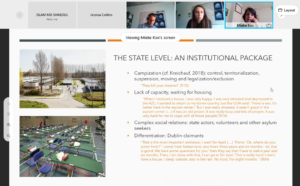
Arrival infrastructures are defined as “those parts of the urban fabric within which newcomers become entangled on arrival, and where their future local or translocal social mobilities are produced as much as negotiated” (Meeus, van Heur, and Arnaut, 2019: 1). In this contribution, we take the concept of arrival infrastructures as a starting point to explore home-makings processes of young refugees and asylum seekers upon arrival in the Netherlands. Drawing on participatory ethnographic research amongst young refugee and asylum youth in Amsterdam, we describe the role of formal, semi-formal and informal structures in material and affective terms and show how these are related to these youngsters’ senses of belonging in the city. We illustrate that refugees usually cannot wait to continue their suspended lives, but they become entangled in a web of reception/asylum seekers centers and civic reintegration requirements upon arrival that hamper their affective inclusion in and contribution to Dutch society. It are usually informal networks consisting of – among others – NGOs and volunteers that help these newcomers feel at home and practice the language. This raises all kind of questions on the current organization of formal arrival infrastructures and its capability of including these youngsters in society in the Netherlands. We try to answer these in this contribution.
Power Dynamics in the Camp Complex Ru’a Al-Abweh (Independent researcher)
It is not enough to discuss global refugee-related work -whether humanitarian or development, in camps or outside camps -without also discussing the power dynamics that are at play and acutely affect people’s lives and the chance of real improvement and development of their places of living. Funding, decision making, processes, agendas, and outcomes are all intimately interwoven with power dynamics -a condition which is likely not unique to one place. In this session, I will reflect on my own experience of developing an initiative that attempted to create a holistic vision for both Azraq Refugee Camp and neighboring Azraq town, as one example of these power dynamics. What was the original intent? What happened in reality? What tensions did we have to grapple with? What worked, even if providing glimpses of hope and potential in small ways? What didn’t work? What are the lessons learned looking back and what questions am I still left with? All of these will be part of my story as a hybrid urban designer/planner/organizer, navigating power while attempting a model of grassroots development, with the aim that it be useful for the global analysis of refugee camps, work with local actors, and connections between camps and neighboring towns or cities.
The governance of migrant reception and more-than-local stories in a Costa Rican border town Elena Reichl (Johannes Gutenberg University Mainz) / Nanneke Winters (Erasmus University Rotterdam)
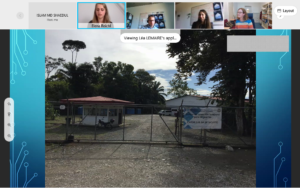
In this paper, we explore how our understanding of the governance of migrant reception centres can be enriched if we consider these centres not as external or exceptional but rather as part of the locality in which they are situated. Although reception centres may be designed based on ideas of exclusion and containment, they exist, function and develop in direct interconnection with their surroundings. Building on fieldwork in a state-run reception centre and its adjacent border town in southern Costa Rica, the paper explores how the centre’s staff and other local migration industry actors, in interaction with an African, Asian and Caribbean population in transit, co-produce daily governance structures and experiences. To do so, we follow Noemi Casati’s (2018) argument that the moral considerations that inform interactions between migrants and local residents not only revolve around locally meaningful social labels (such as legal status, ethnicity and nationality), but also incorporate the historical, political and economic configurations in which a centre is situated. In the paper, we consider such configurations through identity ‘stories’ that can be traced locally yet integrate cross-border and global dynamics. These stories include a shared sense of falling into oblivion, in this town that was built from scratch by the United Fruit Company in the 1930s but abandoned again in the 1980s; an appreciation of a certain cosmopolitanism that transiting migrants bring along; a diversity of sometimes conflicting conceptualisations and designations of the reception centre; and a welcoming of border-oriented informal business for petty traders, taxi drivers, and former migrants alike. These more- than-local stories not only structure relationships with and within the centre, but also help us look beyond the care and control governance dynamics that are usually considered in reception literature.
The impact of migration policy in Zaatari camp on refugee family life: mobilities, work and gender roles Valentina Napolitano (Ifpo, ITHACA)
By reconstructing the trajectory of the members of a Syrian refugee family in the Zaatari camp in Jordan, this paper proposes to analyze the impact of humanitarian assistance programs and Jordanian migration policy on the reconfiguration of the family sphere. On the one hand, it will analyze the way in which certain programs that designate women as “vulnerable” have favored their access to education and work, and for the youngest among them, resettlement in third countries (Europe and Canada). On the other hand, restrictions on mobility outside the camp and limitations on access to the labor market have rather affected men by hindering their ability to find a job. These changes in the contribution to the family economy have not, however, reconfigured the unequal distribution of domestic tasks according to gender. This paper will also analyze the strategies used by members of this family to circumvent a number of constraints (in terms of mobility and subsistence) and the way in which forms of solidarity have emerged within the camp in order to cope with the difficult living conditions (surveillance, electricity cuts, lack of water). This paper is based on multiple visits and interviews conducted within Zaatari camp, between 2019 and 2020.
Local authority in informal Syrian refugee camps in Lebanon: divide- and-rule under a regime of strategic ambiguity Nora Stel (Radboud University)
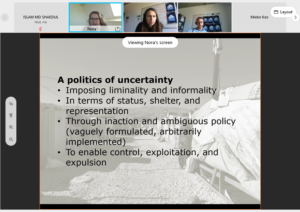
This paper embraces the local turn in refugee studies. In particular, it explores the role of local authorities in the management of refugee settlements for which they are not officially made responsible. Drawing on an epistemic politics perspective, the paper engages with questions of representation, organization, and acknowledgment in the context of informal Syrian refugee settlements in Lebanon. The paper, using qualitative fieldwork data and critical policy analysis, focuses on relations between local camp representatives, so-called shawishes, and local Lebanese authorities. It concludes that shawishes are simultaneously informally propped up and co-opted and formally denied and disowned by municipalities and security agencies. The paper discusses these dynamics from a multi-scalar perspective. It brings in a national context in which alternative, and potentially less repressive, forms of refugee representation are actively undermined by Lebanese state officials who at the same time, without providing guidelines or resources for this, put pressure on municipalities to register refugees. The subsequent local dynamics in which state authorities strategically support refugee leaders yet dissociate themselves from them, the paper argues, can best be understood as representing a specific manifestation of a broader governmentality of strategic institutional ambiguity. Such a politics of uncertainty keeps refugees’ status, shelter, and representation arrangements informal, liminal, and exceptional in order to enable their control, exploitation, and expulsion. As such, the case-study material speaks to academic debates about what defines and determines campness, putting a special premium on the explanatory value of strategic ambiguity, ambivalence, uncertainty, and inaction.
Bulle as border spectacle: inclusive exclusion in an urban dispositif of migration reception, Paris 2016-2018 Melora Koepke (Simon Fraser University)
This paper investigates the urban politics of the European migration “crisis” through sustained and fine-grained investigation of a key site: the Centre de premier accueil Paris-Nord (CPA), France’s first and Europe’s largest urban migration facility that operated in the city’s Porte de La Chapelle neighbourhood from 2016-2018. With its architecturally remarkable centerpiece nicknamed the “Bulle de Paris” (Paris Bubble), the CPA was a temporary municipal experiment presented as a humanitarian dispositif providing emergency shelter and orientation for a large number of precarious migrants whose informal encampments were proliferating in the northern districts of the French capital since 2015. This paper argues, however, that the CPA’s function far exceeded its stated initial mission and that it was in fact a true Foucauldian dispositif – that is, a governmental apparatus created in response to a crisis that also shaped the crisis in its becoming. Drawing on evidence from an extended site ethnography conducted in situ for the CPA’s entire duration, I demonstrate how the site functioned as a border spectacle, shaping the politics of the crisis at the local and national scales while materially enacting migrants’ inclusive exclusion through three modalities of socio-spatial control: shelter, triage and exception.
Forced migration as urban development: Berlin’s accommo- dation approach and the development of sheltering as the new urban norm René Kreichauf (Vrije Universiteit Brussel) / Elizabeth Cullen Dunn (Indiana University Bloomington)
Even though cities are the frontline players in dealing with forced migration through the development of local integration and housing policies, urban studies research has only recently started to pay attention to the urban aspects of asylum or to structures and forms of governing refugee migration at the local level. This paper analyzes Berlin’s accommodation developments for forced migrants. The findings illustrate that because of Berlin’s tense housing market and the lack of affordable housing, the development of asylum accommodations has become a tool for urban planning, housing and neighborhood development. The construction of accommodation is used to convert non-residential areas, which were previously politically or legally difficult to access, into housing areas through the back door using a “refugee” or “humanitarian” designation. This strategy has a dual rationale: it develops multi-purpose housing with an institutional character for forced migrants, but simultaneously aims to provide lower-cost, sub-standard social housing for other lower- income groups, including the homeless. Thus, the logic and practices of shelter infuses housing and the living situations of those that fall out of Berlin’s competitive housing market. This development serves political and economic interests: Shelters are predominantly placed in socioeconomically weak areas with low voter turnouts, where the local government has nothing to lose politically, but where Berlin’s housing companies can develop profitable land and gain higher profit rates because the purchase of land, the construction of asylum accommodation and the housing of forced migrants are federally subsidized.
Fragmented landscapes of refugee reception: the role of local actors in Switzerland Camilla Alberti (University of Neuchâtel)
Drawing upon an ethnographic research conducted in three reception centers, this paper aims to extend the understanding of how refugee reception is made through the everyday practices of local actors. More specifically, it addresses the role of a variety of state-mandated entities – non-profit association, charity and for-profit company – in negotiating and (co-)constructing the realities of “camps” in Swiss cantons. By connecting narratives to day-to-day practices, but also analyzing the way these are (materially) embodied in reception facilities, it explores how different characteristics of organizations create a divergence in a supposedly homogeneous policy. Through the analysis of the data collected, I show that refugee reception is on the ground completely fragmented. It is indeed translated into a multitude of narratives and practices, which navigate between the efficient use of public resources and the protection of migrants’ well-being according to the organization’s understanding of the common weal. I illustrate how asylum reception is part of a continuum between supervision, in the sense of ‘framing’ the daily life of asylum seekers to ensure their (minimal) well-being, and psychosocial assistance, including the treatment of traumas and psychological disorders. More broadly, this article argues that local actors, by positioning themselves between advocacy and service provision, mediate not only the formation of policy, but broader dynamics such as its de- or repoliticization. By examining (the possibility for) alternative imaginings and practices of asylum reception, it sheds light on the spaces of resistance or critique vis-à-vis the standards of service delivery.
From Moria and Kakuma to inclusive approaches ‘from below’: the role of local actors in camps across the World Claudia Böhme (University of Trier) / Caroline Schmitt (University of Klagenfurt)
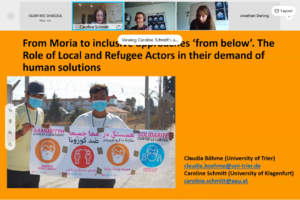
Refugee camps are a specific form of the institution of the “camp”, which in recent global history represents a special type of exercise of violence and power (Greiner et al. 2013). In the last decade, many studies have highlighted the conflictual, sometimes violent everyday situations that are caused by the structural and institutional character of these institutions (see Täubig 2009; Bauer 2017; Christ et al. 2017 et al.). In this context refugee camps are theorized in the frame of social processes of power, control and security (Pieper 2008) and described as “total institutions” (Goffman 1961), in which everyday life is framed and strongly regulated by administrative restraints. Due to occurring human rights violations, conflicts and violence, local welfare organisations, IOs, NGOs and refugee councils have since long demanded a more humanitarian accommodation and the establishment of complaint management systems, minimum standards and concepts for protection against violence. In our contribution, we want to discuss the influence and agency of local actors and refugees in the establishment of quality management systems, self- help structures and organisations as well as alternative solidary models of accommodation in Germany, the Hotspots at the EU borders and in Kenya. The practical implementation of sustainable improvements is a major challenge, as lack of resources, power hierarchies, conflicts and violence are system inherent to refugee camps. In the negotiation with local actors and inhabitants of refugee camps who demand to improve the living standards in the camps, local politics, power and hierarchies, trust/ distrust dynamics, intercultural communication and cultural sensitivity play a crucial role.
Appropriating Azraq camp: between disciplinary planning and resistance Ayham Dalal (Technische Universität Berlin)
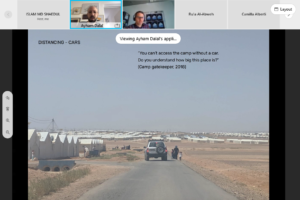
Refugee camps are dispositives of care and control. While they offer refugees with shelters, they also suspend them from inhabiting it. In this paper, and using the case of Azraq camp in Jordan, we will show how notions of securitisation, appropriation and dwelling are interlinked. By applying a multi-scalar approach, we will demonstrate that refugees’ appropriation will always be present from below regardless of how advanced the technologies of discipline used to hinder it. Taking this tension between securitisation and dwelling as a starting point, we situate dwelling as a cursor for exploring these spatial practices. While securitisation prevents refugees from dwelling, appropriations fight to enable it. In that sense, not only the power to appropriate and to inhabit will always be present in camps whether planned or not, but within these cracks of thinking from above that moments of organic reorganisation from below happens the “right to appropriate” can be revisited within the realm of the domestic space.
A Palimpsest of diaspora: interpreting graffiti in Al Wehdat Camp, Jordan Nama’a Abdullah Qudah (TU Delft)
Urban graffiti has always been situated between two contrasting notions: street art or vandalism, artistic expression or criminal activity. Refugee Camps, on the other hand, developed around contrasting phenomena, permanence vs. transience, and inclusion vs. exclusion. This research aims to explore urban graffiti in Al Wehdat Camp in Jordan, by conceptualizing the camp’s walls as a palimpsest that hold traces and layers of expression by the camp inhabitants through time. By referencing Andre Corboz in his book Land as Palimpsest (Corboz, 1983), the camp will not be investigated as a given, but a condensation of time’s different social, political and economic processes. The reoccurring themes in the graffiti can highlight certain concepts and ideologies that are of prominent importance to camp inhabitants, especially when studying graffiti as a tool of communication and public expression. Moreover, this paper will study graffiti’s underlying processes of appropriation and the boundary between public and private, in addition to the different ways graffiti expresses notions of Palestinian identity and acts of resistance against forgetting. Deducing graffiti through the use of photographs will uncover how the different social groups in the camps have claimed space, expressed their ideologies, and utilized the camp as an urban space for remembering and celebrating the Palestinian identity.
Can the refugee speak? Decolonial and affective commoning practices of “Refugee tv” and “Refugees got talent” in Idomeni and Thessaloniki camps Charalampos Tsavdaroglou (University of Amsterdam)
In the winter of 2016, a group of refugees that lived in the makeshift camp of Idomeni, self-organized an initiative called ‘refugee tv’. The members of the group performed the journalists, yet, imitating and ridiculing official media. When in May 2016 the Idomeni camp was evacuated and all refugees were relocated to State-run camps on the perimeter of Thessaloniki, the ‘refugee tv’ team created a network of ‘refugee tv’ sub- groups that expressed the refugees’ voices of each camp. At the same time, they organized another project called ‘refugees got talent’, in which each refugee talked about her/his talents and tried to regain his/her dignity. These projects were the starting point for several uprisings and protests inside the refugee camps. Diverse studies and reports have discussed the various actions of NGOs, volunteer groups, activists and State policies on migration. However, in this discussion there is a lack of refugees’ testimonies, of their voices, gestures, embodied practices and interactions. This paper inspired by the mobile commons and autonomy of migration approaches and attempts to cover this gap. In addition, although radical approaches on commons recognize the critical importance of commoning practices, there is a lack of in-depth analysis on the affective aspect of commoning gestures among the refugees. This paper drawing on theories of affect and decolonial geography and attempts to explore this issue. Based on participatory observation and militant research, the paper investigates how newcomers employ mimicking practices to subvert official forms and power relations, claim visibility, and produce hybrid common spaces inside the refugee camps.
Calais then (2016) and then (2019) Liam Healy (Goldsmiths, University of London)
Calais Then (2016) and Then (2019) is a two-screen video depicting the former ‘Jungle’ camp in Calais, France. The film juxtaposes footage shot during a tandem bicycle tour of the camp in 2016, the height of the Jungle’s activity, with footage retracing the same route in 2019, after the camp was shut down. By revealing the rewilding taking place amidst unused roads and uninhabited shelters, the film is a study into which kinds of life are permitted in a Europe increasingly hostile to displaced people. In 2016, the Jungle camp was home to an estimated 10,000 people and was largely self-built by both displaced people and volunteers working on the site, with little state or NGO intervention. Before the camp was cleared in November 2016, I had set out to explore the ways image-making practices might be symmetrised between researcher and research-subject. To do this I made and deployed the tandem bicycle with cameras and interview equipment used in the film, which could be piloted and ridden by the camp’s residents, volunteers and researchers to record an account of the lived experiences of displaced people in Calais, and the architectures that they had built. In the intervening years, the site has been turned into an ‘eco-park’, the landscape having been modified to be a home for birds and a tourist attraction. In this setting, ‘natural’ ecology (or perhaps more accurately ‘green-washing’) is cultivated to erase displaced people, their histories, and practices for survival. In the camp-become-eco-park, instead of finding those that populated the roads, shops and shelters that I had encountered before, evening primrose flowers have taken root, thick scrub, a community of horses, artificially constructed sand dunes, various small ponds, and a bird viewing hide. These new ‘architectures’ take on a new function as part of wider bordering practice in France. The ponds flood the area to prevent people from being able to camp in the space, and the bird hide and newly built board walks provide the regularly patrolling CRS police with vantage points for surveilling the area.
Offshoring and outsourcing: the refugee industry in the Republic of Nauru Julia Morris (University of North Carolina Wilmington)
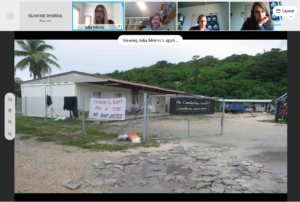
With the political potency of migrant and refugee demonization, governments have brokered trade deals to extend the geographies of asylum into new third country resettlement sites far beyond their borders. This paper draws on fieldwork conducted in the Republic of Nauru to explore the Australian government’s practice of outsourcing asylum to Pacific island nations. This tactic of migration control has become part of a broader arrangement that extends the spatial distribution of detention centres and camps; indigenising them into new sovereign territorial domains, haunted by their own colonial histories. Nauru, the world’s smallest island state, at just 21km2, was almost entirely economically dependent on the phosphate industry in the twentieth century. After the wealth it derived from phosphate extraction was depleted by the 1990s, the by then sovereign state resurged on the back of the refugee industry, importing Australia’s maritime asylum seeker populations. Anyone who makes their way by boat and claims to be a refugee in Australian territorial now excised waters is ‘offshored’ to Nauru or Papua New Guinea’s Manus Island for refugee processing and resettlement. This paper shifts the analysis away from a socio-legal or humanitarian frame towards a political economic approach centred on resource extraction. Ultimately, I argue that refugees are an industry that has had a hugely negative impact on local and refugee populations in Nauru. By focusing on the political economies that operate in Nauru with regard to refugees, the article shows the continuities between resource extractive histories and the socio-spatial formations of displacement and confinement more globally.
Migration management and uneven development? The economic geographies of migrant camps Panos Hatziprokopiou (Aristotle University of Thessaloniki)
The paper explores the economic interactions between local societies, mobile populations and spatial dimensions of migration management, seeking to detect the diverse economic practices, exchanges, and relations surrounding migrant camps in the Greek context. Its main focus is on the key economic actors and the multiple spatialities produced. There appears to be a variety of such actors: private or state, individual or collective, local or transnational, formal or informal – including actors in sectors and activities who would not otherwise be related to migration at all, hence extending well beyond what is often captured by the emerging field of research on the “migration industry”. Not all such actors have an equal standing in this process, yet they cross-cut in various ways and sometimes interplay in a number of overlapping networks instigating forms of “development” and stimulating “market” at multiple scales: from networks of food production and distribution catering for camp populations to makers and resellers of tents or containers; from transport and tourist industries to local housing markets; and from informal economic arrangements built around camp life to employment for NGOs operating in camps or private companies catering for them. Building on past and ongoing research, the paper attempts a tentative hypothesis is that the adopted policies create value and mobilise resources in ways that resemble business clusters, fostering growth and employment in the wider economy yet at the same time enhancing existing inequalities or producing new ones, with those primarily affected, yet least benefiting, being the migrants themselves.
Humanitarian governance as development: protracted refugee camps as drivers of investment and innovation in refugee hosting regions Bram J. Jansen (Wageningen University)
The impact of protracted refugee camps on their host environments has been subject of increasing academic and policy attention. Such camps have often been viewed as isolating and secluding spaces, sustaining a security threat and a burden for host communities and the environment. However, recent studies posit such camps as potential drivers of development, particularly in marginalised environments. Novel forms of international engagement and investment materialise in these refugee hosting regions, such as hybrid camps and durable settlements that seek to govern and maintain refugee camp structures and services that simultaneously benefit ‘host’ populations. For a large part this concerns measures aimed at contributing to self-reliance of refugees, employment opportunities for host communities, and forms of burden sharing with host countries, but also programs linking camps to agricultural investment, irrigation and environmental programs such as reforestation and waste management in their host regions. This feeds into the rationale of camps as development opportunities, and marries contemporary geopolitical concerns over migration and regional solutions to refugee crises with environmental and climate agendas, and innovative investment. This paper explores how and to what effect protracted refugee camps enable investment and innovation in refugee hosting regions outside of initial camp boundaries, based on extensive literature review and ethnographic fieldwork in a variety of these regions.

)
